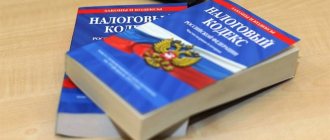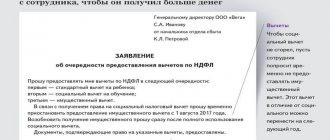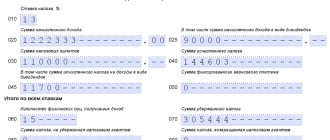Kontur.Accounting expert Anna Baranova helps accountants understand changes to standard deductions. New codes and new payment amounts will need to be used when calculating personal income tax and wages for December 2011.
On December 26, the Rossiyskaya Gazeta published Order of the Federal Tax Service of Russia dated December 6, 2011 N ММВ-7-3/909 “On amendments to the annexes to the order of the Federal Tax Service dated November 17, 2010 N ММВ-7-3/611”.
This Order specifies new codes for standard deductions. The amounts of standard deductions and the procedure for their calculation are established by Federal Law No. 330-FZ dated November 21, 2011. In Kontur.Accounting, all relevant changes to codes and amounts have already been implemented.
We recommend that you do the following as soon as possible:
Quick accounting of deductions in Kontur.Accounting
Try it
- find out the order of the employees’ children (now this nuance matters);
- manually replace standard deductions for children in the employee’s personal data in Kontur;
- recalculate personal income tax taking into account current changes;
- return the excess amounts withheld along with the salary for December 2011.
Let's look at the changes in amounts and codes in order:
- The deduction of 400 rubles (code 103) has been canceled since 2012.
- The usual deduction per child in the amount of 1000 rubles (code 108) in 2011 and 2012 now depends on the child’s priority:
New code 2011 2012 First 114 1000 rub 1400 rub. Second 115 1000 rub 1400 rub. Third and every subsequent 116 3000 rub 3000 rub - The deduction for a disabled child, which was previously provided in the amount of 2,000 rubles (code 109), according to the new rules is 3,000 rubles (code 117), in 2012 - 3,000 rubles.
- If the only parent or the second parent refuses deductions, deductions for children are still provided in double amount. Please note that new codes for such deductions are also indicated in the new order.
- The limit on the amount of income up to which deductions are provided remains the same - 280,000 rubles.
Deductions for children in 2011
Before the adoption of the commented amendments, the standard deduction for each child was 1,000 rubles. for every month. It did not matter how many children the taxpayer has and for which of them the deduction is provided.
Now the size of the “children’s” deduction depends on how the child was born. So, the deduction for the first and second child is 1000 rubles each. for each month, and for the third and subsequent children - 3,000 rubles. for each month (new edition of subparagraph 4 of paragraph 1 of Article 218 of the Tax Code of the Russian Federation).
This amendment came into force on November 22, 2011 (the date of official publication of the law under comment) and applies to legal relations that arose from January 1, 2011. This means that accountants will have to retroactively recalculate the personal income tax base for all employees who have three or more children. Moreover, you need to make the necessary adjustments when calculating salaries for November.
How to return excessively withheld amounts?
The entire sequence of actions when returning excessively withheld tax is determined by Art. 231. Tax Code of the Russian Federation. This article states that within 10 days of discovering that an employee has been overpaid, we must notify the employee. Then, within three months, we must return the amounts excessively withheld from the employee.
There are several options at the expense of which amounts you can return the tax: at the expense of the personal income tax of other taxpayers, the organization’s own funds, and besides this, the missing amount can be requested directly from the Federal Tax Service. We must remember that if we delay payment, we will incur penalties. Please note that returns are only possible in cashless form. The employee is required to write an application for a refund of over-withheld tax and indicate in it the account or bank card details.
Deductions for children in 2012 and beyond
Starting from January 1, 2012, the amount of “children’s” deductions will increase. For the first and second child it will be 1,400 rubles each. for each month, and for the third and each subsequent child - 3,000 rubles.
In what case is an increased deduction due for the third child?
The question arises whether a deduction of 3,000 rubles is due. in case the first two children (or one of them) are adults?
There are two opposing points of view.
Some experts believe that an increased deduction is possible only if the employee has two children, for each of whom a deduction of 1,000 rubles is currently provided. In other words, if the older children have not yet reached the age of 18 or are students (graduate students, interns, etc.) not older than 24 years.
Others argue that since there are no restrictions or additional conditions in the Tax Code, an “increased” deduction should be given for the third child, regardless of the age of the first two children. It is this interpretation that was confirmed by the Russian Ministry of Finance in letter dated December 8, 2011 No. 03-04-05/8-1014.
Accounting for personal income tax deductions in the program “1C: Salaries and Personnel Management 8”
The codes and amounts of standard deductions in the 1C: Salaries and Personnel Management 8 program were automatically changed when the information base was updated to release 2.5.42 (Fig. 1).
Rice. 1
However, updating the reference information does not automatically redefine employee deductions under the new rules. In order to apply innovations in the Tax Code of the Russian Federation when calculating personal income tax, it is necessary for all employees with two or more children to change the codes of applied deductions and the number of children.
In order to make it as easy as possible for an accountant to redefine employee deductions, an Assistant for editing deductions for children has been added to the configuration, starting with release 2.5.43.
This service allows each employee for whom the right to child deductions under the old rules was already registered before January 1, 2012, to change the deduction records so that they comply with the new rules. Commands for calling the Assistant are located on the Taxes tab of the Desktop, as well as in the Taxes and Contributions menu next to the command for entering property deductions.
When you select an organization in the service dialog box, all employees eligible for child deductions are automatically selected into the list. When you position the cursor on an employee from the list, the top table displays previously entered deduction entries, and the bottom table is intended to display edited entries that will be valid in 2012.
For each employee, depending on his individual situation, one of four automatic editing algorithms can be applied (Fig. 2).
Rice. 2
1. Do not replace deductions - this algorithm can be used for employees with one child. It, as the name suggests, does not make any changes to the deduction entries;
2. Leave deductions for the first and second children - this algorithm is intended for those employees who support two or more children, and everyone, including the eldest, gives him the right to a deduction. In this case, a deduction is allocated with code 114/108 (for the first child) - number of children 1, deduction with code 115 (for the second child) - number of children 1 and for all remaining children a deduction with code 116 is added (for the third and further children) ;
3. Leave a deduction only for the second child - this algorithm is intended for those parents whose eldest child has already grown up and a deduction is not provided for him. In this case, the previously used deduction with code 114/108 is terminated, but two new entries are created - for deduction with code 115 and the number of children 1 and for deduction with code 116 - for the remaining children
4. Replace with deductions for the third child - this algorithm is intended for parents whose children who are entitled to deductions are third (fourth, etc.). In this case, the previously used deduction with code 114/108 is terminated and one new entry is created for deduction with code 116 for all children.
Records created by the service can be edited. The data displayed in the lower field is saved to the database only by clicking the Write deductions and close button.
For newly hired employees or employees who have submitted an application for deductions for the first time, the data must be entered immediately in accordance with the new rules.
There is no need to delete entries on the use of personal deduction with code 103 (400 rubles), since the program will not take this deduction into account when calculating personal income tax for 2012.
Since the recalculation of personal income tax for 2011 is now carried out by the tax office, no retroactive tax calculations are no longer made.
Deductions for disabled children
Previously, the deduction for a disabled child under 18 years of age, as well as for a full-time student, graduate student, resident, student, cadet under the age of 24 and a disabled person of group I or II, was doubled. Simply put, for such a child, the deduction for each month was 2,000 rubles. (1000 rub. x 2).
Now the deduction amount for this category has changed and is equal to 3,000 rubles. per month. This value must be applied retroactively from the beginning of 2011, that is, the tax base for personal income tax for the current year must be recalculated.
In 2012 and beyond, the amount of the standard deduction for disabled children will not change and will remain equal to 3,000 rubles. for every month.
Other conditions for providing “children’s” deductions
Another innovation concerns the list of persons who are entitled to “children’s” deductions. Previously, the list included parents and their spouses, adoptive parents and their spouses, as well as guardians and trustees. Now adoptive parents have also been added to them.
As for other conditions, they remained the same. Thus, “children’s” deductions, as before, are due to the taxpayer until his income reaches 280,000 rubles. year to date. Starting from the month in which this limit is exceeded, the standard deduction for children does not apply.
The only parent (including adopted), guardian, trustee and adoptive parent have the right to receive a double deduction. However, upon marriage, starting from the month following the wedding, the deduction becomes single.
Finally, at the request of the parents, one of them can refuse the deduction in favor of the other. In this case, the second parent will receive a double deduction.
New codes for standard deductions
As you know, when filling out a certificate in form 2-NDFL, the accountant must indicate the amount of each type of deduction in the line with the corresponding code. The values of the codes are given in Appendix No. 4 to the order of the Federal Tax Service of Russia dated November 17, 2010 No. ММВ-7-3/ [email protected] The Federal Tax Service has now prepared changes that take into account the new values of standard deductions. At the moment, the amendments have not yet been adopted, but a draft of the future order has already been published. It is highly likely that new codes will be approved in the near future.
Codes for new deduction values given in the draft order of the Federal Tax Service of Russia
| Deduction code | Name of deduction |
| 114 | For the first child under the age of 18, as well as for each full-time student, graduate student, resident, student, cadet under the age of 24 to a parent, spouse of a parent, guardian, trustee, foster parent, spouse of a foster child parent who cares for the child |
| 115 | For a second child under the age of 18, as well as for each full-time student, graduate student, resident, student, cadet under the age of 24 to a parent, spouse of a parent, guardian, trustee, foster parent, spouse of a foster child parent who cares for the child |
| 116 | For the third and each subsequent child under the age of 18, as well as for each full-time student, graduate student, resident, student, cadet under the age of 24 to a parent, spouse of a parent, guardian, trustee, foster parent, spouse ( spouse) adoptive parent who is providing for the child |
| 117 | For a disabled child under the age of 18 or a full-time student, graduate student, resident, student under the age of 24, who is a disabled person of group I or II, to a parent, spouse of a parent, guardian, trustee, foster parent, spouse ) adoptive parent who is caring for the child |
| 118 | In double the amount for the first child under the age of 18, as well as for each full-time student, graduate student, resident, student, cadet under the age of 24 to the only parent (adoptive parent), guardian, trustee |
| 119 | In double the amount for the second child under the age of 18, as well as for each full-time student, graduate student, resident, student, cadet under the age of 24 to the only parent (adoptive parent), guardian, trustee |
| 120 | In double the amount for the third and each subsequent child under the age of 18, as well as for each full-time student, graduate student, resident, student, cadet under the age of 24 to the only parent (adoptive parent), guardian, trustee |
| 121 | In double the amount for a disabled child under the age of 18 or a full-time student, graduate student, resident, student under the age of 24, who is a disabled person of group I or II to the only parent (adoptive parent), guardian, trustee |
| 122 | In double the amount for the first child under the age of 18, as well as for each full-time student, graduate student, resident, student, cadet under the age of 24 to one of the parents (adoptive parents) of their choice based on an application for refusal of one of parents (adoptive parents) from receiving a tax deduction |
| 123 | In double the amount for the second child under the age of 18, as well as for each full-time student, graduate student, resident, student, cadet under the age of 24 to one of the parents (adoptive parents) of their choice based on an application for refusal of one of parents (adoptive parents) from receiving a tax deduction |
| 124 | Double the amount for the third and each subsequent child under the age of 18, as well as for each full-time student, graduate student, resident, student, cadet under the age of 24 to one of the parents (adoptive parents) of their choice based on an application for refusal of one of the parents (adoptive parents) to receive a tax deduction |
| 125 | Double the amount for a disabled child under the age of 18 or a full-time student, graduate student, resident, student under the age of 24 who is a disabled person of group I or II, to one of the parents (adoptive parents) of their choice based on an application for refusal of one of the parents (adoptive parents) to receive a tax deduction |
Providing for the child
The main condition under which the specified persons are granted a deduction is providing for the child.
For your information.
In family law, another term is directly used, namely “child maintenance” (clause 1 of article 80 of the RF IC).
We believe that these terms are synonymous and interchangeable. In general, the legislation does not establish a list or procedure for drawing up documents that are submitted to confirm, in particular, participation in the maintenance of a child (Resolution of the Federal Antimonopoly Service of Ukraine dated October 29, 2008 N F09-7923/08-C2).
The Ministry of Finance takes a similar position: the Tax Code of the Russian Federation does not contain a list of documents necessary to confirm the taxpayer’s right to a deduction based on the form of child support; depending on the specific case, the composition of the documents may be different (Letter dated December 13, 2011 N 03-04-05/5- 1021).
At the same time, there is an opinion that the condition for recognition of the fact that parents provide for a child is their joint registration (parents and child) at the same place of residence. In this regard, of interest is the Letter of the Ministry of Finance of Russia dated May 11, 2012 N 03-04-05/8-629, in which, on the basis of Art. 80 of the RF IC, the following conclusion is made: the fact of registration of a child at a place of residence different from the place of registration of the parents is not in itself a basis for failure to provide a tax deduction established by paragraphs. 4 paragraphs 1 art. 218 Tax Code of the Russian Federation. If a child actually lives with his parents and is supported by them, then regardless of the child’s registration at the place of residence of one of the parents, both parents have the right to receive a standard tax deduction.
The fact that a spouse lives together with children can be confirmed by a certificate from the place of residence of the relevant housing maintenance organization (unified information and settlement center), or a certificate from a homeowners’ association, housing or housing construction cooperative, or a certificate from the city, town and rural administration, as well as can be established in court (letters of the Ministry of Finance of Russia dated September 18, 2013 N 03-04-05/38670, dated April 2, 2012 N 03-04-05/8-402).
In addition, documents to confirm the right to receive a standard tax deduction for a child, in particular, can be a copy of the child’s birth certificate, as well as a written statement from the wife that the husband actually lives with the child and participates in providing for him (letters from the Ministry of Finance of Russia dated 01/15/2013 N 03-04-05/8-18, dated 08/22/2012 N 03-04-05/8-991, dated 04/15/2011 N 03-04-06/7-95).
It is advisable to say that one of the forms of providing for children is the payment by the parent of alimony for the maintenance of the child.
If the marriage between the parents is dissolved, then the parent who is in a second marriage and lives separately from the children must submit copies of the children’s birth certificates and documents confirming the payment of alimony for the maintenance of minor children to confirm the right to a tax deduction (clause 2 of the Letter of the Ministry of Finance of Russia dated 02/10/2012 N 03-04-06/8-33).
Since the right of a divorced parent to receive a standard tax deduction for children is confirmed by the fact of payment of alimony to ensure the maintenance of children, such a taxpayer has the right to receive a tax deduction regardless of place of residence (Letter of the Ministry of Finance of Russia dated October 11, 2012 N 03-04-05/8-1179 ).
If child support is paid in accordance with the procedure and in the amount established by the Family Code, the parent has the right to receive a tax deduction (Letter of the Ministry of Finance of Russia dated April 21, 2011 N 03-04-05/5-275).
If a parent has minor children from a previous marriage, whose support is confirmed by the payment of alimony, it should be borne in mind that, by virtue of Art. 34 RF IC and Art. 256 of the Civil Code of the Russian Federation, property acquired by spouses during marriage (common property of spouses) includes the income of each spouse, including that part of the income that is then transferred in the form of alimony to support the child, that is, the spouse has the right to receive a standard tax deduction for the parent’s child (letter of the Federal Tax Service of Russia dated September 17, 2013 N BS-4-11/16736, Ministry of Finance of Russia dated June 27, 2013 N 03-04-05/24428, dated April 17, 2013 N 03-04-05/12978).









